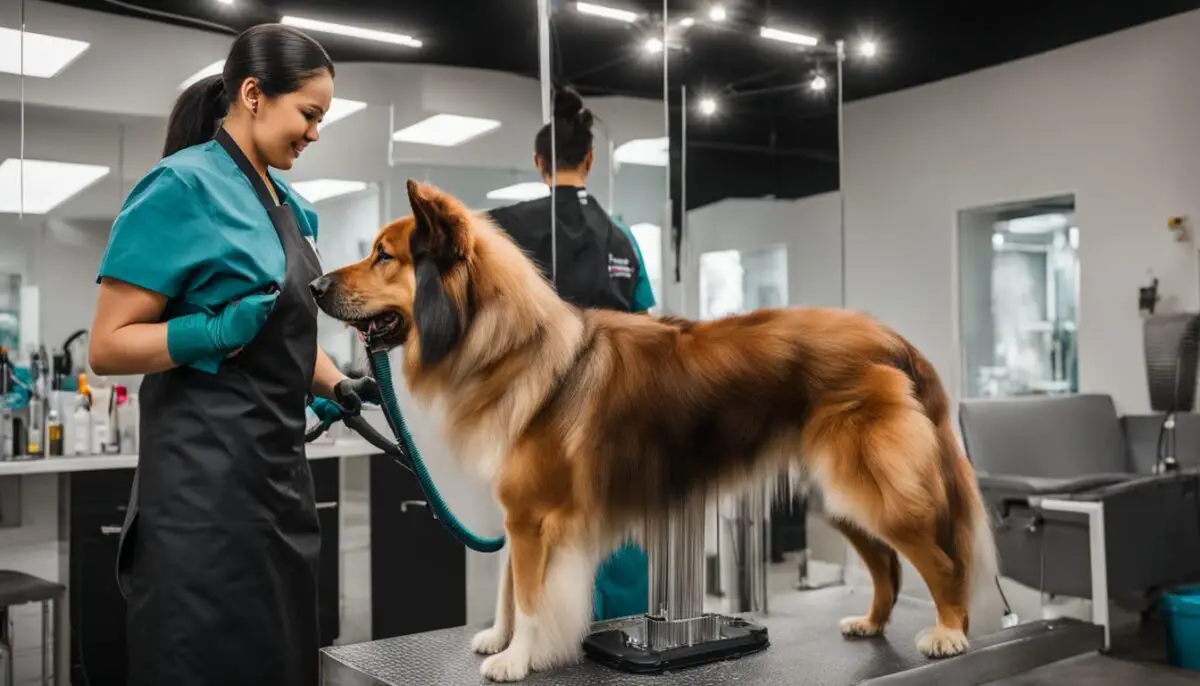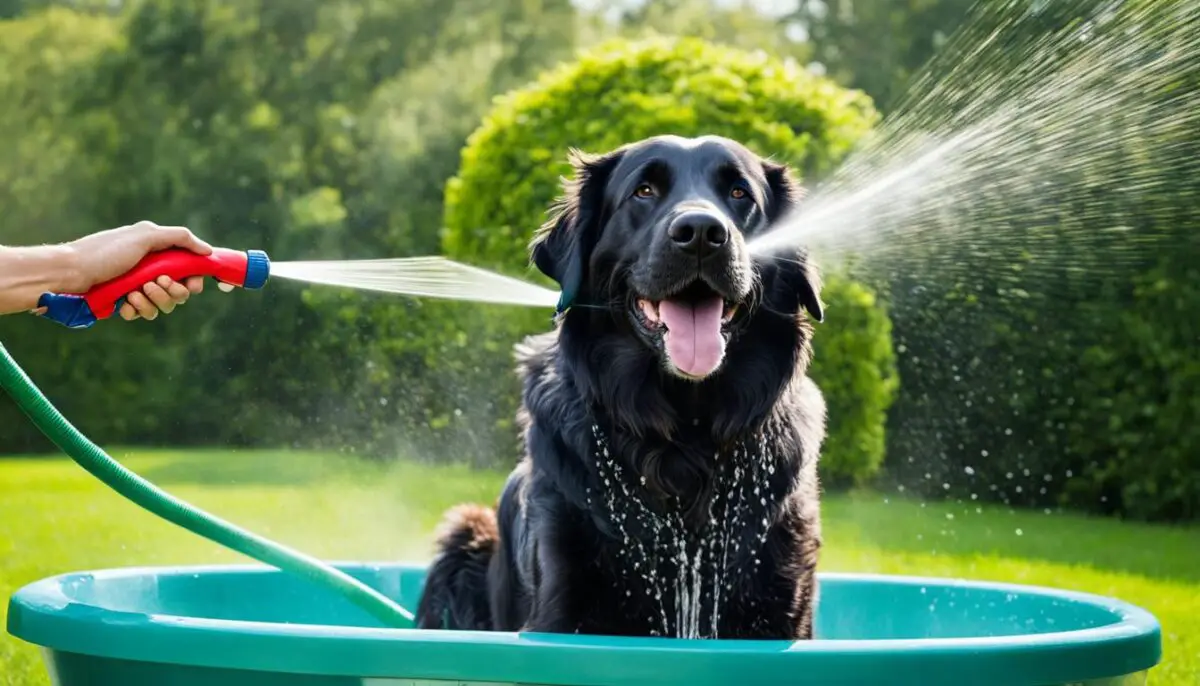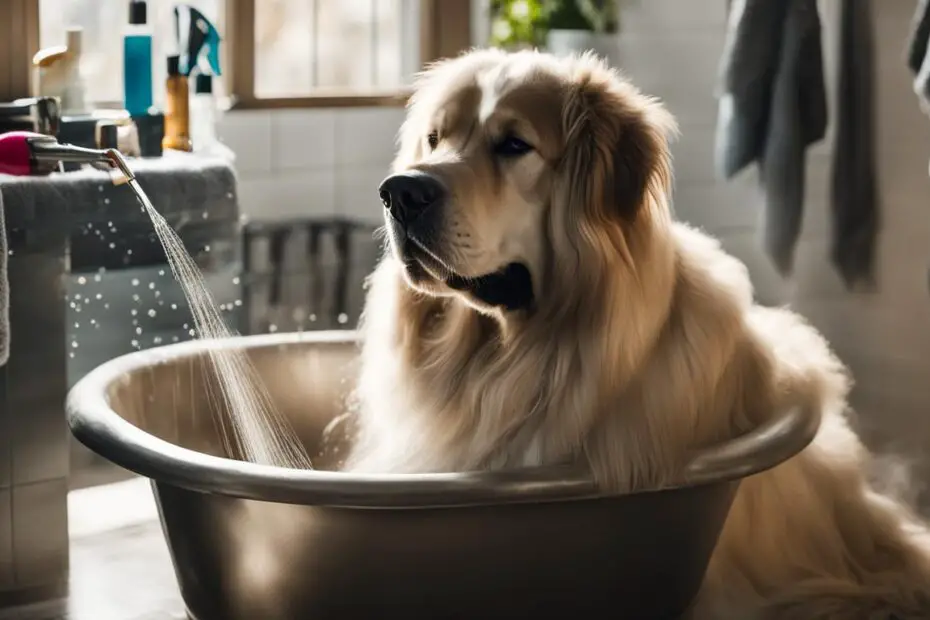Grooming big dogs can be a challenge, but with the right tips and tricks, you can keep their coat looking its best. Regular grooming is essential for large breeds to maintain healthy fur and prevent matting and tangles. In this guide, we’ll cover everything you need to know about grooming big dogs, from brushing techniques to nail trimming and more.
Key Takeaways:
- Regular grooming is crucial for maintaining the health of big dogs’ coats.
- Invest in the right grooming tools, such as slicker brushes and de-shedding tools.
- Bathing should be done on an as-needed basis, using dog-friendly shampoo.
- Nail trimming is important to avoid discomfort and walking problems.
- Pay attention to your big dog’s oral hygiene and sanitary care.
Importance of Regular Brushing for Big Dogs
Regular brushing is essential for maintaining the health and appearance of big dogs’ coats. It helps remove dead hair, prevents tangles and mattes, and improves circulation. When grooming large dogs, it’s important to use the right tools to effectively remove loose hair and keep their coat neat.
Here are some tips for grooming large dogs:
- Use grooming tools such as slicker brushes and de-shedding tools to effectively remove loose hair.
- Brush your dog at least once a week, but some breeds may require more frequent brushing, especially those with long or curly fur.
- Establish a regular grooming routine to keep your dog’s coat in top condition.
Grooming practices for big dogs can vary depending on their breed and fur type. Some breeds may require additional grooming, such as coat trimming or de-matting. Consult with a professional groomer or do research on the specific grooming needs of your dog’s breed.
Best Grooming Tools for Large Dogs
Using the right grooming tools is crucial for effective and comfortable grooming sessions with your big dog. Here are some essential tools:
| Tool | Description |
|---|---|
| Slicker Brush | A slicker brush is perfect for removing loose hair and tangles from your dog’s coat. Its fine, short bristles reach deep into the fur without causing discomfort. |
| De-shedding Tool | A de-shedding tool is designed to remove excess hair from your dog’s undercoat. It helps reduce shedding and keeps the coat looking tidy. |
| Grooming Comb | A grooming comb is useful for detangling and smoothing out your dog’s fur. It can be particularly helpful for breeds with long hair or thick coats. |
| Nail Clippers | Proper nail care is essential for big dogs. Invest in high-quality nail clippers designed for large breeds to keep their nails trimmed and prevent discomfort. |
Ensure that you choose grooming tools that are specifically designed for large dogs to make the grooming process efficient and comfortable for both you and your furry friend.

Comparison of Home Grooming vs. Professional Grooming
| Aspect | Home Grooming | Professional Grooming |
|---|---|---|
| Expertise | Requires knowledge and practice | Performed by experienced groomers |
| Equipment | Basic grooming tools | Specialized grooming equipment |
| Time | Can vary based on grooming skills | Efficient and time-saving |
| Services | Basic grooming routine | Full range of grooming services |
| Special Needs | May require additional research | Can cater to specific breed needs |
Nail Trimming and Oral Hygiene for Big Dogs
Grooming your big dog involves more than just keeping their coat looking good. Nail trimming and oral hygiene are two important aspects of their grooming routine that should not be neglected.
Keeping your dog’s nails trimmed is essential for their comfort and mobility. Overgrown nails can cause discomfort and even lead to problems with walking. Regular nail trimming is necessary to prevent these issues.
When trimming your dog’s nails, it’s important to use proper nail clippers. Choose clippers that are specifically designed for dogs and ensure they are the appropriate size for your big dog’s nails.
Tip: Using a nail grinder can also be a great alternative to clippers, especially if your dog is sensitive or anxious about nail trimming.
When trimming the nails, be cautious not to cut too much off. Only trim the tips, taking care to avoid cutting the quick, which is the sensitive inner part of the nail. Cutting the quick can cause bleeding and pain for your dog.
If you’re unsure about trimming your dog’s nails, it’s best to consult a professional groomer or a veterinarian for guidance. They can demonstrate the proper technique and provide advice on how to handle your dog’s nails safely.

Tips for Grooming Specific Big Dog Breeds
Different big dog breeds may have specific grooming needs. It’s important to understand the unique requirements of your dog’s breed to ensure you maintain their grooming standards. By tailoring your grooming routine to meet their needs, you can keep your big dog looking and feeling their best. Here are some tips to help you groom specific big dog breeds:
Grooming Long-Haired Breeds
For breeds with long, flowing hair like Retrievers or Setters, regular and thorough brushing is crucial to avoid tangles and keep their coat looking sleek and healthy. Consider using professional grooming services to maintain optimal grooming standards for these breeds. Here is a recommended grooming routine for long-haired breeds:
- Brush their coat at least three times a week to prevent matting and tangling. Use a slicker brush or a comb with wide teeth to untangle any knots gently.
- Trim their hair around the ears, paws, and tail to maintain a neat appearance.
- Have professional grooming sessions every six to eight weeks to keep their coat in top condition.
Grooming Breeds with Thick Fur
Breeds with thick fur like Huskies or Malamutes require regular de-shedding to control excessive shedding. By following this grooming routine, you can keep their fur manageable and reduce the amount of loose hair in your home:
- Use a de-shedding brush or tool to remove loose hair from their undercoat.
- Bathe them once every two to three months to keep their fur clean and healthy.
- Regularly check for any mats or tangles and gently remove them using a slicker brush or comb.
Regardless of the breed, it’s always a good idea to consult a professional groomer for expert advice and guidance tailored to your dog’s specific needs. They can provide valuable insights into the ideal grooming routine for your big dog breed.
“Each big dog breed requires a unique grooming approach. Understanding their specific needs will help you keep your dog’s coat healthy and beautiful.”
Grooming Tips for All Big Dog Breeds
While different breeds have specific grooming requirements, there are some tips that apply to all big dog breeds. By following these general grooming practices, you can maintain grooming standards for your big dog:
- Regularly check and clean their ears to prevent infections.
- Brush their teeth regularly to maintain good oral hygiene.
- Trim their nails every 3-4 weeks to prevent overgrowth and discomfort.
Remember that grooming is not just about aesthetics but is also essential for your dog’s overall health and well-being. By dedicating time and effort to grooming your big dog, you can ensure they are happy, healthy, and looking their best.
Conclusion
Grooming big dogs requires commitment, patience, and knowledge. By following the tips and tricks outlined in this guide, you can confidently groom your large breed and maintain their coat with ease. Regular brushing is crucial for keeping their fur healthy and preventing tangles and mattes.
Proper bathing techniques, such as using dog-friendly shampoo and having all necessary supplies, are key factors in maintaining grooming standards for big dogs. Additionally, don’t forget about nail trimming and oral hygiene. Regular trimming and teeth brushing are essential for their overall health and well-being.
Attention to sanitation and dealing with odor is also important. Keeping your big dog’s bedding clean, regularly cleaning their ears and teeth, and maintaining their sanitary areas will help keep them smelling fresh and prevent health issues.
Remember to tailor your grooming routine to your specific big dog breed’s needs, as each breed may have unique grooming requirements. Seek professional help when necessary, especially for breeds with more complex grooming needs. With proper care and grooming practices, your big dog will be healthy, happy, and well-groomed.
FAQ
How often should I brush my big dog?
Brushing should be done at least once a week, but some breeds may require more frequent brushing, especially those with long or curly fur.
How often should I bathe my big dog?
Bathing big dogs should be done on an as-needed basis, as frequent baths can dry out their skin and dull their fur.
What tools should I use for grooming my big dog?
It’s important to use the right tools, such as slicker brushes and de-shedding tools, to effectively remove loose hair and keep their coat neat.
Can I groom my big dog myself or should I hire a professional?
While you can groom your big dog yourself, professional grooming services can be beneficial, especially for breeds with more complex grooming needs.
How do I trim my big dog’s nails?
It’s important to use proper nail clippers and trim only the tips of the nails to avoid cutting the quick, which can cause bleeding.
Do big dogs require dental care?
Regular teeth brushing and dental check-ups are important for maintaining good oral health and preventing dental issues in big dogs.
How do I prevent my big dog from smelling bad?
Regular brushing, washing their bedding, using deodorizing products, and paying attention to their sanitary care can help keep big dogs smelling fresh.
Are there specific grooming needs for different big dog breeds?
Yes, different big dog breeds may have specific grooming requirements. It’s important to research your specific breed to understand their unique needs.

